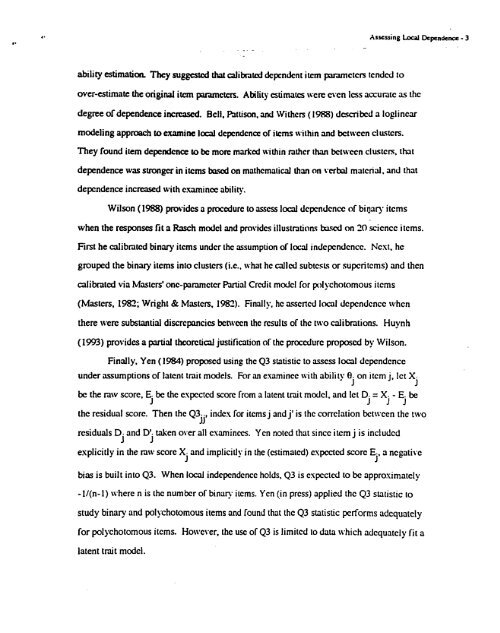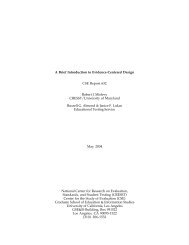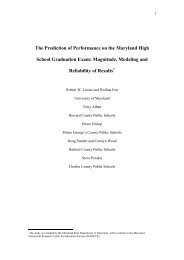Assessing Local Dependence in Educational Performance ...
Assessing Local Dependence in Educational Performance ...
Assessing Local Dependence in Educational Performance ...
You also want an ePaper? Increase the reach of your titles
YUMPU automatically turns print PDFs into web optimized ePapers that Google loves.
Asscss<strong>in</strong>$ <strong>Local</strong> Del~nClenc~ - 3ability estimation. They suggested that calibra~cl dependent itcrn parameters tended toov'er-estimatc the origirm[ itcrn parameters. Ability estimates ~'erc even less accurate as thedegree of dependence <strong>in</strong>creased. Bell, Pattison, and Withers (1988) described a Iogl<strong>in</strong>earmodel<strong>in</strong>g approach to exam<strong>in</strong>e local dependence of items with<strong>in</strong> and between clusters.They found item dependence to be more marked with<strong>in</strong> rather than between clusters, thatdependence was stronger <strong>in</strong> items ba.~:d on mathematical than on verbal material, and thatdependence <strong>in</strong>creased with exam<strong>in</strong>ee ability.Wilson (1988) provides a proc~ure to assess local dependence of bioary itemswhen the responses fit a Rasch modcl and provides illustrations ba.~'d on 20 science items.First he calibrated b<strong>in</strong>ary items under the assumption of local <strong>in</strong>dependence. Next. hegrouped the b<strong>in</strong>ary itcms <strong>in</strong>to clusters (i.e., what he called subtests or superitems) and thencalibrated via Masters' one-parameter Partial Credit model for i:x)lychotomous items(Masters, 1982_; Wright & Masters, 1982). F<strong>in</strong>ally, he osserted local dependence whenthere were substantial discrepancies between the results of the two calibrations. Huynh(1993) provides a partial theoretical justification of the procedure proposed by Wilson.F<strong>in</strong>ally, Yen (1984) proposed us<strong>in</strong>g the Q3 statistic to assess local dependenceunder assumptions of latent trait models. For an exam<strong>in</strong>ee with ability 0j on item j, let Xjbe the raw score, Ej be the expected score from a latent trait model, and let Dj = Xj - Ej bethe residual score. Then the Q3jj, <strong>in</strong>dex for itemsj andj' is the correlation between the tworesiduals Dj and D'j taken over all exam<strong>in</strong>ees. Yen noted that s<strong>in</strong>ce item j is <strong>in</strong>cludedexplicitly <strong>in</strong> the raw score Xj and implicitly <strong>in</strong> the (estimated) expected score E, a negativebias is built <strong>in</strong>to Q3. When local <strong>in</strong>dependence holds, Q3 is expected to be approximately-1/(n-l) where n is the number of b<strong>in</strong>ary items. Yen (<strong>in</strong> press) applied the Q3 statistic tostudy b<strong>in</strong>ary, and polychotomous items and found that the Q3 statistic performs adequatelyfor polychotomous items. However, the use of Q3 is limited to data which adequately fit alatent trait model.






